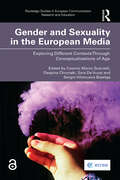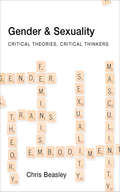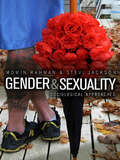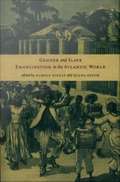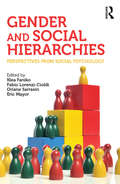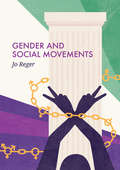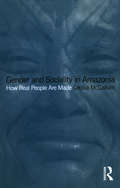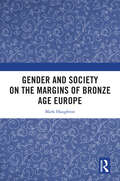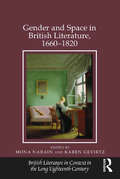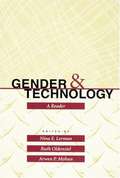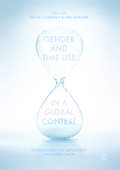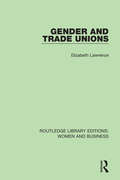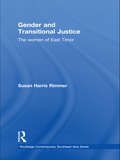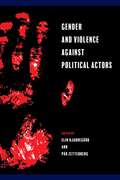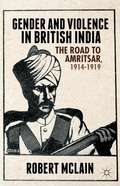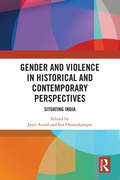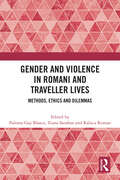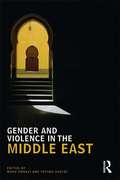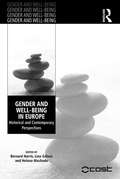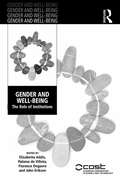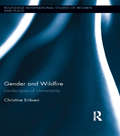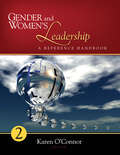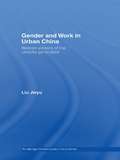- Table View
- List View
Gender and Sexuality in the European Media: Exploring Different Contexts Through Conceptualisations of Age (Routledge Studies in European Communication Research and Education)
by Cosimo Marco ScarcelliThis edited collection brings together original empirical and theoretical insights into the complex set of relations which exist between age, gender, sexualities and the media in Europe. This book investigates how engagements with media reflect people’s constructions and understandings of gender in society, as well as articulations of age in relation to gender and sexuality; the ways in which negotiations of gender and sexuality inform people’s practices with media, and not least how mediated representations may reinforce or challenge social hierarchies based in differences of gender, sexual orientation and age. In doing so, it showcases new and innovative research at the forefront of media and communication practice and theory. Including contributions from both established and early career scholars across Europe, it engages with a wide range of hotly debated topics within the context of gender, sexuality and the media, informing academic, public and policy agendas. This collection will be of interest to students and researchers in gender studies, media studies, film and television, cultural studies, sexuality, ageing, sociology and education.
Gender and Sexuality: Critical Theories, Critical Thinkers
by Chris BeasleyThis accessible introduction to gender and sexuality theory offers a comprehensive overview and critique of the key contemporary literature and debates in feminism, sexuality studies and men's studies. Chris Beasley's clear and concise introduction combines a wide-ranging survey of the major theorists and key concepts in an ever-growing and often passionately debated field. The book contextualizes a wide range of feminist perspectives, including: modernist, liberal, postmodern, queer and gender difference feminism; and in the realm of sexuality studies covers modernist liberationism, social constructionism, transgender theorising and queer theory. In men's studies, Chris Beasley examines areas of debate ranging from gender and masculinity to questions of race, ethnicity, imperialism and gay masculinities. Interconnections between the subfields are highlighted, and Beasley considers the implications of body theory for all three. Key theorists covered include: Altman· Brod· Butler · Califia· Carbado· Connell· Dowsett ·Grosz· Halberstam· Hook · Jackson· Jagose· Nussbaum· Rich· Seidman· Spivak· Stoltenberg· Weeks· Whittle· Wolf· Wollstonecraft The only book of its kind to draw together all the important strands of gender analysis, Gender and Sexuality is a timely and impressive overview that is invaluable to students and academics taking courses on gender and feminist theory, sexuality and masculinity.
Gender and Sexuality: Sociological Approaches (Gender And Culture Ser.)
by Stevi Jackson Momin RahmanThis new introduction to the sociology of gender and sexuality offers a fresh take on the importance of these concepts in modern society. It provides an insight into our rapidly changing attitudes towards sex and our understanding of masculine and feminine identities, relating the study of gender and sexuality to wider social concerns throughout the world and presenting a comprehensive yet readable summary of recent research and theory. In an accessible and engaging style, the book demonstrates how thinking about gender and sexuality can illuminate and enliven other contemporary sociological debates about social structure, social change, and culture and identity politics. Emphasis is placed on the diversity of gendered and sexual lives in different parts of the world. The book offers detailed coverage of wide-ranging topics, from international sex-tourism to celebrity culture, from gender in the work-place to new sexual lifestyles, drawing examples from everyday life. By demonstrating the links between gender and sexuality this book makes a clear case for thinking sociologically about these important and controversial aspects of human identity and behaviour. The book will be of great value to students in any discipline looking to understand the roles gender and sexuality play in our lives.
Gender and Slave Emancipation in the Atlantic World
by Pamela Scully Diana PatonThis groundbreaking collection provides the first comparative history of gender and emancipation in the Atlantic world. Bringing together essays on the United States, Brazil, Cuba, Puerto Rico, West Africa and South Africa, and the Francophone and Anglophone Caribbean, it shows that emancipation was a profoundly gendered process, produced through connections between race, gender, sexuality, and class. Contributors from the United States, Canada, Europe, the Caribbean, and Brazil explore how the processes of emancipation involved the re-creation of gender identities--the production of freedmen and freedwomen with different rights, responsibilities, and access to citizenship. Offering detailed analyses of slave emancipation in specific societies, the contributors discuss all of the diverse actors in emancipation: slaves, abolitionists, free people of color, state officials, and slave owners. Whether considering the construction of a postslavery masculine subjectivity in Jamaica, the work of two white U. S. abolitionist women with the Freedmen's Bureau after the Civil War, freedwomen's negotiations of labor rights in Puerto Rico, slave women's contributions to the slow unraveling of slavery in French West Africa, or the ways that Brazilian abolitionists deployed representations of femininity as virtuous and moral, these essays demonstrate the gains that a gendered approach offers to understanding the complex processes of emancipation. Some chapters also explore theories and methodologies that enable a gendered reading of postslavery archives. The editors' substantial introduction traces the reasons for and patterns of women's and men's different experiences of emancipation throughout the Atlantic world. Contributors. Martha Abreu, Sheena Boa, Bridget Brereton, Carol Faulkner, Roger Kittleson, Martin Klein, Melanie Newton, Diana Paton, Sue Peabody, Richard Roberts, Ileana M. Rodriguez-Silva, Hannah Rosen, Pamela Scully, Mimi Sheller, Marek Steedman, Michael Zeuske
Gender and Social Capital (Gender Politics--Global Issues)
by Elisabeth Gidengil Brenda O'NeillThe volume brings together a stellar group of contributors who examine the social capital thesis by means of four different approaches: theoretical, historical, comparative, and empirical. In the end, this book will serve to answer two fundamental questions which have hitherto been neglected: What can a gendered analysis tell us about social capital? And what can social capital tell us about women and politics?
Gender and Social Hierarchies: Perspectives from social psychology
by Eric Mayor Klea Faniko Fabio Lorenzi-Cioldi Oriane SarrasinGender and Social Hierarchies offers a fresh and coherent picture of applied research from within social psychology on the intricate relationship between gender and social status. It comprises a collection of innovative approaches which seek to understand the pervasiveness of status asymmetry between gender categories. Drawing upon recent theoretical advances in gender psychology, the book provides tools for developing practical and political recommendations to address and resolve status inequality today. Each chapter examines a different aspect of the impact that gender-based social hierarchies have on people’s lives. Part One explores the consequences of gender stereotypes in school, higher education, and in professional settings. The struggles faced by women in the workplace are discussed in Part Two, featuring topics such as work-life balance, the ‘glass cliff’, and the lack of support for affirmative action. Part Three is devoted to the antecedents and consequences of gender-based forms of prejudice, such as discrimination against gay men, and against women within cultural minorities. The book concludes with some practical suggestions for working towards lasting and beneficial change. Gender and Social Hierarchies will appeal to scholars and students across the social sciences and offers important insights to practitioners and policy-makers.
Gender and Social Movements (Social Movements)
by Jo RegerHow does gender influence social movements? How do social movements deal with gender? In Gender and Social Movements, Jo Reger takes a comprehensive look at the ways in which people organize around gender issues and how gender shapes social movements. Here gender is more than an individual quality, it is a part of the very foundation of social movements, shaping how they recruit, mobilize and articulate their strategies, tactics and identities. Moving past the gender binary, Reger explores how movements can shift understandings of gender and how backlash and countermovements can often follow gendered movement successes. Adopting both an intersectional and global lens, the book introduces readers to the idea that gender as a form of societal power is integral in all efforts for social change. With a critical overview across different types of movements and gender activism, such as the women’s liberation, #Metoo and transgender rights movements, this book offers a solid foundation for those seeking to understand how gender and social movements interact.
Gender and Sociality in Amazonia: How Real People Are Made
by Cecilia McCallumThis is the first book to focus directly on gender in Amazonia for nearly thirty years. Research on gender and sexual identity has become central to social science during that time, but studies have concentrated on other places and people, leaving the gendered experiences of indigenous Amazonians relatively unexplored. McCallum explores little-known aspects of the day-to-day lives of Amazonian peoples in Brazil and Peru. Taking a closer look at the lives of the Cashinahua people, the book provides fascinating insights into conception, pregnancy and birth; naming rituals and initiation ceremonies; concepts of space and time; community and leadership; exchange and production practices; and the philosophy of daily life itself. Through this prism it shows that in fact gender is not merely an aspect of Amazonian social life, but its central axis and driving force. Gender does not just affect personal identity, but has implications for the whole of community life and social organization. The author illustrates how gender is continually created and maintained, and how social forms emerge from the practices of gendered persons in interaction. Throughout their lives, people are 'being made' in this part of the Amazon, and the whole of social organization is predicated on this conception. The author reveals the complex inter-relationships that link gender distinctions with the body, systems of exchange and politics. In so doing, she develops a specific theoretical model of gender and sociality that reshapes our understanding of Amazonian social processes. Building on the key works from past decades, this book challenges and extends current understandings of gender, society and the indigenous people of Amazonia.
Gender and Society on the Margins of Bronze Age Europe
by Mark HaughtonThis book explores and critiques the underlying assumption that a binary gender system and patriarchal norms were universal in Bronze Age Europe through a careful analysis of burial practice in Ireland and Scotland.Gender and Society on the Margins of Bronze Age Europe makes a decisive and critical intervention in the debate around the nature of gender in the European Bronze Age. Tacking between scales, from the detail of local practice to a major analysis of recently excavated and analysed skeletons, it argues that binary gender was far from universal in Bronze Age Europe, and consequently questions its broader importance. Unlike bronze technology, shared widely between communities across Europe, binary gender was an optional or negotiable part of Bronze Age life. The book goes on to assess the huge implications of this evidence firstly, for the history of gender, as it indicates that there was no simple linear trajectory to binary gender and patriarchy and secondly, by demonstrating that interconnectivity in Bronze Age Europe did not result in fundamental social and ideological agreement, undermining the idea of a shared Bronze Age society. At its core, the book reimagines how gender archaeology can be conducted, inspired by the sub-discipline’s radical origins and following a method rooted in the detail of local practice.This book is essential reading for scholars and students of the European Bronze Age, gender (pre)history, and gender archaeology. It connects with major themes in theoretical thinking across the humanities, particularly relating to posthumanism, assemblage theory, embodiment and gender.
Gender and Space in British Literature, 1660-1820 (British Literature in Context in the Long Eighteenth Century)
by Mona Narain Karen GevirtzBetween 1660 and 1820, Great Britain experienced significant structural transformations in class, politics, economy, print, and writing that produced new and varied spaces and with them, new and reconfigured concepts of gender. In mapping the relationship between gender and space in British literature of the period, this collection defines, charts, and explores new cartographies, both geographic and figurative. The contributors take up a variety of genres and discursive frameworks from this period, including poetry, the early novel, letters, and laboratory notebooks written by authors ranging from Aphra Behn, Hortense Mancini, and Isaac Newton to Frances Burney and Germaine de Staël. Arranged in three groups, Inside, Outside, and Borderlands, the essays conduct targeted literary analysis and explore the changing relationship between gender and different kinds of spaces in the long eighteenth century. In addition, a set of essays on Charlotte Smith’s novels and a set of essays on natural philosophy offer case studies for exploring issues of gender and space within larger fields, such as an author’s oeuvre or a particular discourse. Taken together, the essays demonstrate space’s agency as a complement to historical change as they explore how literature delineates the gendered redefinition, occupation, negotiation, inscription, and creation of new spaces, crucially contributing to the construction of new cartographies in eighteenth- and early nineteenth-century England.
Gender and Technology: A Reader
by Nina E. Lerman Ruth Oldenziel Arwen P. MohunFor most of human experience, certainly of late, the artifacts of technological civilization have become closely associated with gender, sometimes for physiological reasons but more often because of social and cultural factors, both obvious and obscure.
Gender and Time Use in a Global Context
by Rachel Connelly Ebru KongarThis edited volume uses a feminist approach to explore the economic implications of the complex interrelationship between gender and time use. Household composition, sexuality, migration patterns, income levels, and race/ethnicity are all considered as important factors that interact with gender and time use patterns. The book is split in two sections: The macroeconomic portion explores cutting edge issues such as time poverty and its relationship to income poverty, and the macroeconomic effects of recession and austerity; while the microeconomic section studies topics such as differences by age, activity sequencing, and subjective well-being of time spent. The chapters also examine a range of age groups, from the labor of school-age children to elderly caregivers, and analyze time use in Argentina, Australia, Canada, China, Finland, India, Korea, South Africa, Tanzania, Turkey, and the United States. Each chapter provides a substantial introduction to the academic literature of its focus and is written to be revealing to researchers and accessible to students and policymakers.
Gender and Timebound Commandments in Judaism
by Elizabeth Shanks AlexanderThe rule that exempts women from rituals that need to be performed at specific times (so-called timebound, positive commandments) has served for centuries to stabilize Jewish gender. It has provided a rationale for women's centrality at home and their absence from the synagogue. Departing from dominant popular and scholarly views, Elizabeth Shanks Alexander argues that the rule was not conceived to structure women's religious lives, but rather became a tool for social engineering only after it underwent shifts in meaning during its transmission. Alexander narrates the rule's complicated history, establishing the purposes for which it was initially formulated and the shifts in interpretation that led to its being perceived as a key marker of Jewish gender. At the end of her study, Alexander points to women's exemption from particular rituals (Shema, tefillin, and Torah study), which, she argues, are better places to look for insight into rabbinic gender.
Gender and Trade Unions (Routledge Library Editions: Women and Business #2)
by Elizabeth LawrenceThis book, first published in 1994, explores the impact of work and gender roles on union activism, and identifies factors that support and hinder women’s representation in trade unions. These issues are discussed in terms of gender role, work-related and union-related factors. The author details what trade unionists are doing to challenge inequalities that still exist, and identifies factors that divide and unite men and women within trade unions. The author shows the impact that feminism has had on the trade union movement and explores the extent to which men and women have similar priorities for collective bargaining.
Gender and Transitional Justice: The Women of East Timor (Routledge Contemporary Southeast Asia Series)
by Susan Harris RimmerGender and Transitional Justice provides the first comprehensive feminist analysis of the role of international law in formal transitional justice mechanisms. Using East Timor as a case study, it offers reflections on transitional justice administered by a UN transitional administration. Often presented as a UN success story, the author demonstrates that, in spite of women and children’s rights programmes of the UN and other donors, justice for women has deteriorated in post-conflict Timor, and violence has remained a constant in their lives. This book provides a gendered analysis of transitional justice as a discipline. It is also one of the first studies to offer a comprehensive case study of how women engaged in the whole range of transitional mechanisms in a post-conflict state, i.e. domestic trials, internationalised trials and truth commissions. The book reveals the political dynamics in a post-conflict setting around gender and questions of justice, and reframes of the meanings of success and failure of international interventions in the light of them.
Gender and Violence against Political Actors
by Elin Bjarnegård and Pär ZetterbergThere has been an increase in testimonies from women politicians who have been targets of violence and from survivors of conflict-related sexual violence. The editors and contributors to of Gender and Violence against Political Actors seek to understand how gender influences both physical and psychological forms of violence and how sexual violence affects both men and women. Chapters focus on theoretical approaches demonstrating how different disciplinary starting points—e.g., politics, violence and gender—give rise to different lenses. Essays examine violence carried out during conflict and peacetime, and relate to the continuum of violence—physical, sexual, psychological, and online. In addition, six country case studies reveal how different types of political actors have been targets of violence. Gender and Violence against Political Actors ends by providing various approaches to responding to the problem of gendered violence in politics while also evaluating policy responses. Contributors: Kerryn Baker, Julie Ballington, Gabrielle Bardall, Gabriella Borovsky, Cheryl N. Collier, Sofia Collignon, Maria Eriksson Baaz, Eleonora Esposito, Nicole Haley, Rebekah Herrick, Sandra Håkansson, Roudabeh Kishi, Anne-Kathrin Kreft, Mona Lena Krook, Rebecca Kuperberg, Robert U. Nagel, Louise Olsson, Jennifer M. Piscopo, Tracey Raney, Juliana Restrepo Sanín, Paige Schneider, Maria Stern, Sue Thomas, and the editors
Gender and Violence in British India
by Robert MclainIn British India, the years during and following World War I saw imperial unity deteriorate into a bitter dispute over "native" effeminacy and India's postwar fitness for self-rule. This study demonstrates that increasingly ferocious dispute culminated in the actual physical violence of the Amritsar Massacre of 1919.
Gender and Violence in Historical and Contemporary Perspectives: Situating India
by Jyoti Atwal Iris FlessenkämperThis book covers a range of issues and phenomena around gender-related violence in specific cultural and regional conditions. Using an interdisciplinary approach, it discusses historical and contemporary developments that trigger violence while highlighting the social conditions, practices, discourses, and cultural experiences of gender-related violence in India. Beginning with the issues of gender-based violence within the traditional context of Indian history and colonial encounters, it moves on to explore the connections between gender, minorities, marginalisation, sexuality, and violence, especially violence against Dalit women, disabled women, and transgender people. It traces and interprets similarities and differences as well as identifies social causes of potential conflicts. Further, it investigates the forms and mechanisms of political, economic, and institutional violence in the legitimation or de-legitimation of traditional gender roles. The chapters deal with sexual violence, violence within marriage and family, influence of patriarchal forces within factory-based gender violence, and global processes such as demand-driven surrogacy and the politics of literary and cinematic representations of gender-based violence. The book situates relevant debates about India and underlines the global context in the making of the gender bias that leads to violence both in the public and private domains. An important contribution to feminist scholarship, this book will be useful to scholars and researchers of gender studies, women’s studies, history, sociology, and political science.
Gender and Violence in Romani and Traveller Lives: Methods, Ethics and Dilemmas
by Paloma Gay Blasco Iliana Sarafian Raluca RomanThis is the first interdisciplinary collection to analyse the place of Romanies and Travellers within contemporary Europe through the lens of gender and violence. In hospitals, schools, and social assistance centres; in encounters with humanitarian agencies and the police; and in media and state representations, violence against Romanies and Travellers is always gendered. The contributors disentangle the array of relations, expectations, and beliefs that make gendered violences against Romanies and Travellers appear necessary, unavoidable, or appropriate. They examine forms of gendered violence that may develop within Romani and Traveller communities against this framework of oppression and attrition.The volume foregrounds the methodological and ethical challenges involved in researching gendered violences in Romani and Traveller contexts, questioning the relationships between gender, violence, and other experiences and concepts such as marginalisation, oppression, exclusion, harm, slow death, social suffering, and necropolitics. The volume is grounded in reflexive feminist standpoints with a collaborative ethos that offers proposals for further analysis, policy development, and engaged practice. It contributes to the theorising of gendered violence in the social sciences by assessing dominant models and perspectives in the light of overlooked Romani and Traveller experiences, and is particularly relevant to scholars from anthropology, gender studies, sociology, and social work.
Gender and Violence in the Middle East (UCLA Center for Middle East Development (CMED) series)
by Fatima Sadiqi Moha EnnajiThis book explores the relationship between Islamism, secularism and violence against women in the Middle East and North Africa. Drawing on case studies from across the region, the authors examine the historical, cultural, religious, social, legal and political factors affecting this key issue. Chapters by established scholars from within and outside the region highlight: the interconnections of violence and various sources of power in the Middle East: the state, society, and the family conceptions of violence as family and social practice and dominant discourse the role of violence as pattern for social structuring in the nation state. By centring the chapters around these key areas, the volume provides an innovative theoretical and systematic research model for gender and violence in the Middle East and North Africa. Dealing with issues that are not easily accessible in the West, this book underlines the importance of understanding realities and problems relevant to Muslim and Arab societies and discusses possible ways of promoting reforms in the MENA region. As such it will be of great interest to students and scholars of gender studies, sociology, political science and criminal justice.
Gender and Well-Being in Europe: Historical and Contemporary Perspectives (Gender and Well-Being)
by Lina GálvezThis book is the first of four books based on a series of symposia funded by COST, which is an intergovernmental framework for the promotion of European Cooperation in the field of Scientific and Technical Research. It draws on both historical and contemporary European case-studies to offer a sophisticated account of the relationship between gender and well-being. The authors focus on key discussions of the changing conceptions of well-being from early twentieth century calculations of the relationship between income and the cost-of-living, to more recent critiques from feminist writers. Their fascinating answers allow them to significantly challenge the issue with the idea that well-being is not only associated with income or opulence but also relates to more abstract concepts including capabilities, freedom, and agency of different women and men and will be of considerable interest to economic and social historians, sociologists of health, gender, sexuality and economists.
Gender and Well-Being: The Role of Institutions (Gender and Well-Being)
by John Eriksen Paloma de VillotaProvisioning for basic human needs is done in three main kind of institutions: the familial household; the commercial enterprise selling goods and services; the institutions of the Welfare State that provide education, medical care and other goods and personal services to all or to some specific groups of citizens in need. The purpose of this book is to study the interplay of these institutions and their impact on well-being, and to analyze key policies and measures that have been implemented in European countries. Institutions determine labour demand (men and women are hired by the institutions of the Welfare State or by market providers of care), the possibilities of consumption (wages earned can be used to buy goods and services only if such goods and services are provided by the market) and allocate people's time, in particular women's time, between paid work and unpaid domestic production and provision of care, shaping both the gender relations and time use of people of both sexes. The proper balance of these institutions is a prerequisite of well-being both of the care givers and of the care receivers, and also for satisfactory gender relations. The chapters in this book focus on the following sub-topics: gender and welfare regimes; gender, well-being and the provision of care in the family and the household; and gender and well-being in the labour market. They emphasise the interdependence of social and labour market policies in the context of fundamental changes in both working patterns (the increase in female labour-force participation rates) and social needs (including population ageing) and demonstrate that we need a more integrated approach to welfare policy which takes account not only of basic welfare entitlements, but also the need for supportive forms of service provision and employment regulation.
Gender and Wildfire: Landscapes of Uncertainty (Routledge International Studies of Women and Place #13)
by Christine EriksenIn pursuit of lifestyle change, affordable property, and proximity to nature, people from all walks of life are moving to the wildland-urban interface. Tragic wildfires and a predicted increase in high fire danger weather with climate change have triggered concern for the safety of such amenity-led migrants in wildfire-prone landscapes. This book examines wildfire awareness and preparedness amongst women, men, households, communities and agencies at the interface between city and beyond. It does so through an examination of two regions where wildfires are common and disastrous, and where how to deal with them is a major political issue: southeast Australia and the west coast United States. It follows women’s and men’s stories of surviving, fighting, evacuating, living and working with wildfire to reveal the intimate inner workings of wildfire response – and especially the culturally and historically distinct gender relations that underpin wildfire resilience. Wildfire is revealed as much more than a "natural" hazard – it is far from gender-neutral. Rather, wildfire is an important means through which traditional gender roles and power relations are maintained despite changing social circumstances. Women’s and men’s subjectivities are shaped by varying senses of inclusion, exclusion, engagement and disengagement with wildfire management. This leads to the reproduction of gender identities with clear ramifications for if, how and to what extent women and men prepare for wildfire.
Gender and Women's Leadership: A Reference Handbook
by Dr Karen P. O'ConnorThis work within The SAGE Reference Series on Leadership provides undergraduate students with an authoritative reference resource on leadership issues specific to women and gender. Although covering historical and contemporary barriers to women's leadership and issues of gender bias and discrimination, this two-volume set focuses as well on positive aspects and opportunities for leadership in various domains and is centered on the 101 most important topics, issues, questions, and debates specific to women and gender. Entries provide students with more detailed information and depth of discussion than typically found in an encyclopedia entry, but lack the jargon, detail, and density of a journal article.Key FeaturesIncludes contributions from a variety of renowned expertsFocuses on women and public leadership in the American context, women's global leadership, women as leaders in the business sector, the nonprofit and social service sector, religion, academia, public policy advocacy, the media, sports, and the artsAddresses both the history of leadership within the realm of women and gender, with examples from the lives of pivotal figures, and the institutional settings and processes that lead to both opportunities and constraints unique to that realmOffers an approachable, clear writing style directed at student researchersFeatures more depth than encyclopedia entries, with most chapters ranging between 6,000 and 8,000 words, while avoiding the jargon and density often found in journal articles or research handbooks Provides a list of further readings and references after each entry, as well as a detailed index and an online version of the work to maximize accessibility for today's student audience
Gender and Work in Urban China: Women Workers of the Unlucky Generation (Routledge Contemporary China Series)
by Jieyu LiuAlthough it is generally believed in China that socialism raised women’s status and paid work liberated them from the shackles of patriarchy, the economic reforms of the last two decades of the twentieth century meant women workers were more vulnerable to losing their jobs than men. Unlike previous studies, which have focused on the macro-structural features of this process, this book makes the voices of ordinary women workers heard and applies feminist perspectives on women and work to the Chinese situation. Drawing upon extensive life history interviews, this book contests the view that mobilizing women into the workplace brought about their liberation. Instead, the gendered redundancy they experienced was the culmination of a lifetime’s experiences of gender inequalities. Setting their life stories against a backdrop of great social-political upheaval in China, the book suggests that the women of this ‘unlucky generation’ have borne the brunt of sufferings caused by sacrifices they made for the development of socialist China.
